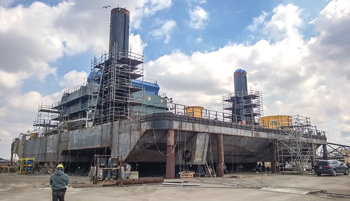 |
| Montco Offshore’s newbuild L/B Jill, shown here at Gulf Island Marine Fabricators yard in Houma, La., is expected to begin sea trials in July. |
|
Government-mandated decommissioning of non-producing platforms may represent dead weight on an operator’s books, but it means big business for companies with the technologies capable of removing structures and disabling wells on the outermost end of the production cycle.
Count family-owned Montco Offshore of Galliano, La., among the companies seeking a substantial chunk of a regional market estimated to be worth hundreds of millions of dollars in the near term. Montco converted its once-diversified fleet of support vessels into one that is dedicated solely to lift boats for the decommissioning market. With this summer’s expected delivery of the newbuild 335-ft L/B Jill, Montco will have a seven-vessel fleet dedicated to decommissioning and P&A in the Gulf.
The business will definitely be there, according to some estimates that have up to a third of the roughly 3,600 Gulf of Mexico platforms set to be decommissioned, and their non-productive wells permanently P&A’d over the next five years. Under its so-called Idle Iron edict, the U.S. has decreed that platforms and wells no longer producing must be completely removed and shut down, one year after officially pronounced off-line. The historical granting of extensions is no longer a given for those platforms, a considerable number of which are concentrated on the shelf.
Once the L/B Jill leaves the Gulf Island Marine Fabricators yard in Houma, La., it will join its two-year-old twin, L/B Robert, as the Cadillacs of the Montco lift boat fleet, said Chief Technology Officer Joseph Orgeron. The Robert and its sister carry 500 cranes with 140-ft booms, and both are rated for 280-ft water depths. Their older siblings in the Montco fleet are 245 ft in length and designed to work in up to 180 ft of water. Orgeron describes the twin vessels as “all-in-one decommissioning machines,” which allow operators to carry out continuous operations with a single vessel and reduce the economic burden of disbanding once-productive wells.
“The Jill is expected to begin sea trials in July, and we hope to begin working by August,” Orgeron said. “Once commissioned, the Jill’s first job is to pick up some downed platforms left from (2005 Hurricane) Katrina, that will be kind of like picking up pixie sticks scattered all over the seafloor. We need the longer (140-ft) crane, so we can reach out and pick up the debris without having to keep moving the vessel.”
Orgeron said the only difference between the Robert and its sister, Jill, is the latter has two bow thrusters on the center line to accommodate its (dynamic positioning) DP2 classification. The Robert was designed as a DP1 vessel and, since its 2012 commissioning, has removed nearly 112 platforms for one Gulf of Mexico operator, Orgeron said.
The Montco technology chief said the newest members of the company’s lift boat fleet reduce operators’ decommissioning costs by having a single vessel conduct continuous operations. Typically, decommissioning and P&A had required the mobilization and demobilization of different vessels for different operations, such as the actual P&A or platform cutting and removal. By way of example, he said using the conventional methodology to remove a four-pile platform, and the associated P&A of four wells in 111 ft of water, required up to 42 days, at a cost of more than $5.6 million. By comparison, the Robert, he said, removed a four-pile structure, with a single-well P&A, in less than 65 hr at a total cost of $485,000.
“Since we can do everything with one boat, the operators save money and time, are less exposed to the environment, and the operation is much safer,” he said. 
INTERMOOR DECOMMISSIONS INNOVATOR PLATFORM
InterMoor, an Acteon company, said it recently completed decommissioning operations on the Innovator platform in the Gulf of Mexico’s deepwater Gomez field, in Mississippi Canyon Block 711.
The work was carried out in 2,986 ft of water and involved disconnecting 10 risers/umbilicals and 12 mooring lines, and towing the platform to Ingleside, Texas. InterMoor said it developed special procedures for both disconnection and towing; and procured rigging and tow equipment for all vessels, including the anchor handling vessel (AHV), the floating production unit (FPU) and tug vessels. InterMoor personnel were assigned to the AHV and FPU through all phases of operations, the company said.
Ironically, InterMoor also provided the mooring design, project management, procurement, installation and hook-up of the mooring system for the Rowan Midland rig that was later converted to the Innovator platform. 
|
|



